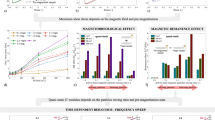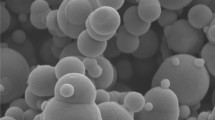Abstract
Magnetorheological elastomers (MREs) are materials made of a soft elastomer matrix filled with magnetizable particles. These flexible composites that deform in response to an externally applied magnetic field are of special interest in advanced engineering applications such as actuators, artificial muscles or shape control. However, no systematic characterization of their coupled response has been undertaken so far, thus limiting the efficient design of MRE-based devices. In this study, we propose a framework—relying on both specially designed samples and a dedicated experimental setup—to characterize experimentally the coupled magneto-mechanical response of MREs since magnetization within the sample is nearly uniform and structural-dependent effects are minimized. The influence of particle content and arrangement within the composite are particularly studied and the corresponding experimental results give some insight into the underlying microstructural mechanisms that are responsible for the macroscopic deformation of MREs under combined magnetic and mechanical loading conditions. Such data is crucial for the design of new MRE composite materials in which the microstructure is optimized (to have the largest coupling effect with minimal energy input).












Similar content being viewed by others
References
Hamrock B (2006) Mechanical Engineers' Handbook: Materials and Mechanical Design. Wiley, Columbus
Rigbi Z, Jilken L (1983) The response of an elastomer filled with soft ferrite to mechanical and magnetic influences. J Magn Magn Mater 37:267–276. https://doi.org/10.1016/0304-8853(83)90055-0
Bustamante R (2007) Mathematical modelling of non-linear magneto-and electro-active rubber-like materials. Dissertation, University of Glasgow
Farshad M, Benine A (2004) Magnetoactive elastomer composites. Polym Test 23:347–353. https://doi.org/10.1016/S0142-9418(03)00103-X
Gong X, Zhang X, Zhang P (2005) Fabrication and characterization of isotropic magnetorheological elastomers. Polym Test 24:669–676. https://doi.org/10.1016/j.polymertesting.2005.03.015
Chen L, Gong X, Jiang W, Yao J, Deng H, Li W (2007) Investigation on magnetorheological elastomers based on natural rubber. J Mater Sci 42:5483–5489. https://doi.org/10.1007/s10853-006-0975-x
Kallio M (2005) The elastic and damping properties of magnetorheological elastomers. Dissertation, VTT Technical Research Centre of Finland
Gong X, Chen L, Li J (2007) Study of utilizable magnetorheological elastomers. Int J M P B 21:4875–4882. https://doi.org/10.1142/S0217979207045785
Carlson JD, Jolly MR (2000) MR fluid, foam and elastomer devices. Mechatronics 10:555–569. https://doi.org/10.1016/S0957-4158(99)00064-1
Jolly MR, Carlson JD, Muñoz BC, Bullions TA (1996) The magnetoviscoelastic response of elastomer composites consisting of ferrous particles embedded in a polymer matrix. J Intell Mater Syst Struct 7:613–622. https://doi.org/10.1177/1045389X9600700601
Ginder JM, Nichols ME, Elie LD, Clark SM (2000) Controllable-stiffness components based on magnetorheological elastomers. SPIE's 7th Annual International Symposium on Smart Structures and Materials. https://doi.org/10.1117/12.388844
Lokander M, Stenberg B (2003) Performance of isotropic magnetorheological rubber materials. Polym Test 22:245–251. https://doi.org/10.1016/S0142-9418(02)00043-0
Elie L, Ginder J, Nichols M, Stewart W (2002) Variable stiffness bushing using magnetorheological elastomers. European Patent
Farshad M, Le Roux M (2004) A new active noise abatement barrier system. Polym Test 23:855–860. https://doi.org/10.1016/j.polymertesting.2004.02.003
Crist RJ (2009) Active vibrational damper. United States Patent
Marur PR (2013) Magneto-rheological elastomer-based vehicle suspension. United States Patent Application Publication
Kim MS, Yang KM, Lee SH, Yoon JH, Jeong UC, Yang IH, Oh JE (2014) Variable differential mount apparatus using magnetorheological elastomer. United States Patent
Thorsteinsson F, Gudmundsson I, Lecomte C (2015) Prosthetic and orthotic devices having magnetorheological elastomer spring with controllable stiffness. United States Patent Application Publication
Diguet G, Beaugnon E, Cavaillé J (2009) From dipolar interactions of a random distribution of ferromagnetic particles to magnetostriction. J Magn Magn Mater 321:396–401. https://doi.org/10.1016/j.jmmm.2008.08.112
Diguet G, Beaugnon E, Cavaillé J (2010) Shape effect in the magnetostriction of ferromagnetic composite. J Magn Magn Mater 322:3337–3341. https://doi.org/10.1016/j.jmmm.2010.06.020
Shen Y, Golnaraghi MF, Heppler G (2004) Experimental research and modeling of magnetorheological elastomers. J Intell Mater Syst Struct 15:27–35. https://doi.org/10.1177/1045389X04039264
Martin JE, Anderson RA, Read D, Gulley G (2006) Magnetostriction of field-structured magnetoelastomers. Phys Rev E 74:051507. https://doi.org/10.1103/PhysRevE.74.051507
Schubert G, Harrison P (2015) Large-strain behaviour of Magneto-Rheological Elastomers tested under uniaxial compression and tension, and pure shear deformations. Polym Test 42:122–134. https://doi.org/10.1016/j.polymertesting.2015.01.008
Schubert G, Harrison P (2016) Equi-biaxial tension tests on magneto-rheological elastomers. Smart Mater Struct 25:015015. https://doi.org/10.1088/0964-1726/25/1/015015
Bossis G, Abbo C, Cutillas S, Lacis S, Métayer C (2001) Electroactive and electrostructured elastomers. Int J M P B 15:564–573. https://doi.org/10.1142/S0217979201005027
Bellan C, Bossis G (2002) Field dependence of viscoelastic properties of MR elastomers. Int J M P B 16:2447–2453. https://doi.org/10.1142/S0217979202012499
Coquelle E, Bossis G (2005) Magnetostriction and piezoresistivity in elastomers filled with magnetic particles. J Adv Sci 17:132–138. https://doi.org/10.2978/jsas.17.132
Kankanala SV (2007) On finitely strained magnetoelastic solids. Dissertation, University of Michigan
Danas K, Kankanala S, Triantafyllidis N (2012) Experiments and modeling of iron-particle-filled magnetorheological elastomers. J Mech Phys Solids 60:120–138. https://doi.org/10.1016/j.jmps.2011.09.006
Mullins L (1948) Effect of stretching on the properties of rubber. Rubber Chem Technol 21:281–300. https://doi.org/10.5254/1.3546914
Mullins L, Tobin N (1957) Theoretical model for the elastic behavior of filler-reinforced vulcanized rubbers. Rubber Chem Technol 30:555–571. https://doi.org/10.5254/1.3542705
Miehe C, Keck J (2000) Superimposed finite elastic-viscoelastic-plastoelastic stress response with damage in filled rubbery polymers. Experiments, modelling and algorithmic implementation. J Mech Phys Solids 48:323–365. https://doi.org/10.1016/S0022-5096(99)00017-4
Coquelle E, Bossis G (2006) Mullins effect in elastomers filled with particles aligned by a magnetic field. Int J Solids Struct 43:7659–7672. https://doi.org/10.1016/j.ijsolstr.2006.03.020
Dekkers M, Heikens D (1983) The effect of interfacial adhesion on the tensile behavior of polystyrene-glass-bead composites. J Appl Polym Sci 28:3809–3815. https://doi.org/10.1002/app.1983.070281220
Gent A, Park B (1984) Failure processes in elastomers at or near a rigid spherical inclusion. J Mater Sci 19:1947–1956. https://doi.org/10.1007/BF00550265
Fu S, Feng X, Lauke B, Mai Y (2008) Effects of particle size, particle/matrix interface adhesion and particle loading on mechanical properties of particulate-polymer composites. Compos Eng 39:933–961. https://doi.org/10.1016/j.compositesb.2008.01.002
Guan X, Dong X, Ou J (2008) Magnetostrictive effect of magnetorheological elastomer. J Magn Magn Mater 320:158–163. https://doi.org/10.1016/j.jmmm.2007.05.043
Osborn J (1945) Demagnetizing factors of the general ellipsoid. Phys Rev 67:351. https://doi.org/10.1103/PhysRev.67.351
ASTM Standard D412-06 (2006) Standard Test Methods for Vulcanized Rubber and Thermoplastic Elastomers-Tension. ASTM International, West Conshohocken. https://doi.org/10.1520/D0412-06
ISO 37:2011 (2011) Rubber, vulcanized or thermoplastic - Determination of tensile stress-strain properties. International Organization for Standardization, Geneva, Switzerland
Galipeau E, Rudykh S, deBotton G, Ponte Castañeda P (2014) Magnetoactive elastomers with periodic and random microstructures. Int J Solids Struct 51:3012–3024. https://doi.org/10.1016/j.ijsolstr.2014.04.013
Goshkoderia A, Rudykh S (2017) Stability of magnetoactive composites with periodic microstructures undergoing finite strains in the presence of a magnetic field. Compos Eng 128:19–29. https://doi.org/10.1016/j.compositesb.2017.06.014
ASTM E8-01 (2001) Standard test methods for tension testing of metallic materials. ASTM International, West Conshohocken. https://doi.org/10.1520/E0008-01
ISO 6892-1:2016 (2016) Metallic materials Tensile testing Part 1: Method of test at room temperature. International Organization for Standardization, Geneva, Switzerland
Brown W (1962) Magnetostatic Principles. North-Holland Publishing Company, Amsterdam
Haynes WM (2014) CRC handbook of chemistry and physics. CRC press, Boca Raton
Schubert G (2014) Manufacture, characterisation and modelling of magneto-rheological elastomers. Dissertation, University of Glasgow
Gorodkin S, James R, Kordonski W (2009) Magnetic properties of carbonyl iron particles in magnetorheological fluids. J Phys Conf Ser 149. https://doi.org/10.1088/1742-6596/149/1/012051
Ciesielski A (1999) An introduction to rubber technology. iSmithers Rapra Publishing, Shawbury
Pössinger T, Bolzmacher C, Bodelot L, Triantafyllidis N (2014) Influence of interfacial adhesion on the mechanical response of magneto-rheological elastomers at high strain. Microsyst Technol 20:803–814. https://doi.org/10.1007/s00542-013-2036-0
Gross H, Singer W, Totzeck M (2005) Handbook of optical systems. Wiley-VCH, Berlin
Lefèvre, V., Danas, K., & Lopez-Pamies, O. (2017). A general result for the magnetoelastic response of isotropic suspensions of iron and ferrofluid particles in rubber, with applications to spherical and cylindrical specimens. J Mech Phys Solids 107:343–364. https://doi.org/10.1016/j.jmps.2017.06.017
Hashin Z (1983) Analysis of composite materials. J Appl Mech 50:481–505. https://doi.org/10.1115/1.3167081
Moon FC, Pao YH (1968) Magnetoelastic Buckling of a Thin Plate. J Appl Mech 35:53–58. https://doi.org/10.1115/1.3601173
Rudykh S, Bertoldi K (2013) Stability of anisotropic magnetorheological elastomers in finite deformations: a micromechanical approach. J Mech Phys Solids 61:949–967. https://doi.org/10.1016/j.jmps.2012.12.008
Ginder J, Clark S, Schlotter W, Nichols M (2002) Magnetostrictive phenomena in magnetorheological elastomers. Int J M P B 16:2412–2418. https://doi.org/10.1142/S021797920201244X
Kankanala S, Triantafyllidis N (2008) Magnetoelastic buckling of a rectangular block in plane strain. J Mech Phys Solids 56:1147–1169. https://doi.org/10.1016/j.jmps.2007.10.008
Davis L (1999) Model of magnetorheological elastomers. J Appl Phys 85:3348–3351. https://doi.org/10.1063/1.369682
Han Y, Mohla A, Huang X, Hong W, Faidley LE (2015) Magnetostriction and field stiffening of magneto-active elastomers. Int J Appl Mech 7:1550001. https://doi.org/10.1142/S1758825115400013
Acknowledgements
The authors acknowledge LMS engineers Vincent De Greef for tailoring the acquisition software to the magneto-mechanical experiments, Erik Guimbretière for his contribution to the setup design as well as François Lelong and Antoine Soler for machining. We also thank Kostas Danas and Nick Triantafyllidis for their help on theoretical and numerical aspects. The contribution of Lingjie Cai during his master internship is also acknowledged.
Author information
Authors and Affiliations
Corresponding author
Rights and permissions
About this article
Cite this article
Bodelot, L., Voropaieff, JP. & Pössinger, T. Experimental investigation of the coupled magneto-mechanical response in magnetorheological elastomers. Exp Mech 58, 207–221 (2018). https://doi.org/10.1007/s11340-017-0334-7
Received:
Accepted:
Published:
Issue Date:
DOI: https://doi.org/10.1007/s11340-017-0334-7




